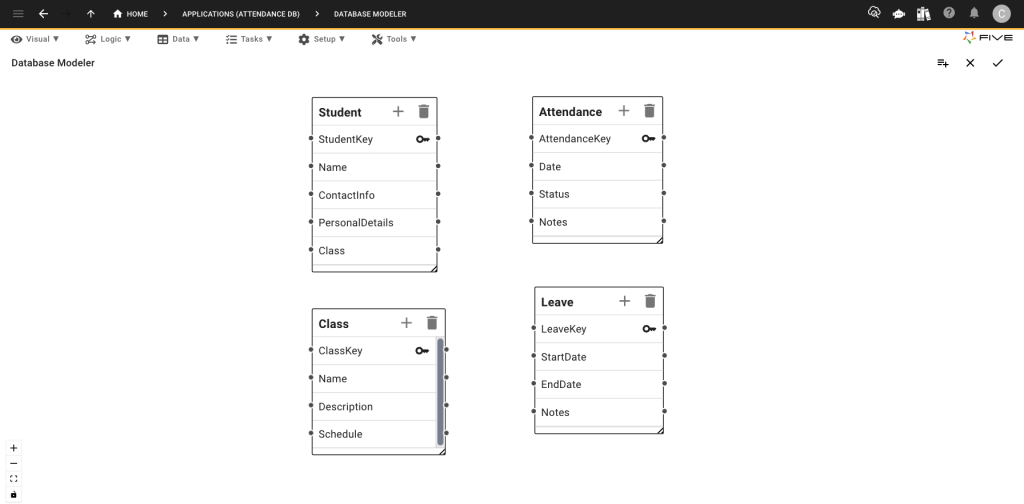Create an Attendance Database In 3 Steps
An attendance database is essential for schools, educational institutions, and organizations that want to effectively manage attendance and track performance.
It serves as the central source of truth for managing student or employee attendance records, monitoring participation, and ensuring compliance with attendance policies.
If you’re unsure where to begin, this guide will walk you through the process of creating an efficient attendance database, helping you avoid issues like inaccurate tracking, attendance-related disputes, and administrative inefficiencies.
Let’s dive in and learn how to develop an attendance database tailored to your needs, whether for a school, college, or workplace.
Why Build an Attendance Database?
A well-designed attendance database is important for ensuring smooth operations in schools, educational institutions, and workplaces. It helps you:
- Track attendance records accurately
- Monitor student or employee participation and performance
- Manage leave requests and approvals
- Ensure timely follow-ups on absences
- Analyze attendance patterns and trends
Having all your attendance information in one centralized system ensures that everyone, from administrators to teachers or managers, is on the same page. This enables better decision-making regarding attendance policies, resource allocation, and addressing absenteeism.
What Is an Attendance Database?
An attendance database is a centralized system that stores detailed information about attendance records, including names, dates, reasons for absence, and any associated actions or notes. It can track student attendance in schools, staff attendance in workplaces, and even attendance at events or classes.
Depending on your needs, you might also track additional attributes like tardiness, participation in specific activities, leave balances, and compliance with attendance policies.
Imagine you’re managing attendance at a school. Your main system might handle the basics, like who attended and who didn’t. But it might not be great at tracking all the details, such as patterns of absenteeism, reasons for leave, or compliance with attendance regulations.
That’s where a well-structured attendance database comes in handy. It serves as a one-stop resource for everything related to attendance. You can easily search and access information, helping you stay on top of attendance records, track trends, and ensure that no issues slip through the cracks.
Why Spreadsheets Fall Short for Attendance Databases
Many institutions start by tracking attendance in Excel or Google Sheets. It might seem convenient at first, especially for smaller organizations. However, as your institution grows, relying on spreadsheets can lead to significant challenges:
- Version Confusion: Different team members may end up with their own versions of the attendance data, leading to a chaotic mess of files like “Attendance_LATEST,” “Attendance – Updated,” or “Old Attendance – IGNORE.” It becomes difficult to know which version is accurate.
- No Clear History: Without a proper system, tracking changes and updates becomes a challenge. If an administrator or teacher leaves, it might be unclear why certain changes were made or what the current status of attendance records is.
- Data Disorganization: As more people interact with the spreadsheet, they might add their own notes, highlight information, or make manual adjustments. Over time, the spreadsheet can become cluttered with conflicting comments and data that are hard to interpret.
Using spreadsheets for attendance data defeats the purpose of having a single, reliable source of information. Instead of efficiently managing attendance, you end up spending time reconciling conflicting data and trying to figure out what’s current.
Building a dedicated attendance database with the right tools can solve these problems. It provides a central, reliable source of information that everyone in your institution can trust and use effectively.
How to Create an Attendance Database in 3 Steps

Typically, creating an attendance database would require knowledge of SQL and user interface design—a daunting task when you’re already managing the day-to-day operations of a school or organization.
That’s why many institutions delay building a proper attendance database. It seems complicated and time-consuming.
But that’s where tools like Five come in. Five is an online database builder that simplifies the process of creating an attendance database.
While it’s not as easy as snapping your fingers, it’s far simpler than spending weeks learning to code from scratch.
With Five, you can:
- Quickly set up your attendance database: Five offers a user-friendly interface and allows you to import your existing attendance records from Excel or other sources, so you don’t have to start from scratch.
- Add custom features: You can create detailed reports on attendance trends, set up charts to visualize attendance data, and track individual attendance at a glance. You can also configure alerts to notify you of any attendance issues, such as repeated absences, ensuring timely interventions.
- Access your database from any device: Whether you’re at your desk or on the go, you can always stay on top of attendance data and make informed decisions in real-time.
Ready to get started? Here’s how:
- Sign up for free
- Create your own attendance database (or use a template to get started)
- Add forms to capture the information you need
- Set up logins for your team, ensuring everyone has access to the attendance data they need.
Building an attendance database has never been easier. With Five, you can improve attendance management and keep your team aligned, all without needing to be a database expert.
Five has a team of experts ready to assist you with your development and customizations. So, if you ever feel like you’re in need of a new dashboard or a form field, don’t worry, our expert developers are here to help. And yes, we promise not to charge you an arm and a leg or leave you with a system that only we understand!
Step 1: What Do You Need to Know About Attendance
First things first, think about what information you really need to track attendance effectively. What matters most to your institution or organization? What do your team, students, or employees care about? You want your attendance database to be the go-to place for all this information, so make it as comprehensive as possible.
Here’s a list of things you might want to keep track of:
- Student/Employee ID and Name
- Dates of attendance and absences
- Reasons for absence
- Tardiness records
- Leave requests and approvals
- Participation in specific activities or classes
- Attendance trends and patterns
- Compliance with attendance policies
- Contact details of students or employees
- Special conditions (e.g., medical notes, exceptions)
Step 2: Think About How You Manage Attendance
Your attendance database isn’t just a list—it’s a tool that should help you manage attendance day-to-day. Consider tracking:
- When attendance is recorded: Record dates and times, who was present, and any absences or late arrivals.
- Follow-ups on absences: Keep notes on when and how absences were addressed, including communication with parents or employees and any required documentation.
- Leave management: Monitor when leave requests are submitted, approved, or denied, and track remaining leave balances.
- Attendance performance: Track trends such as recurring absences or improvements over time, and identify any patterns that need addressing.
The more detailed your records, the more valuable your database will become. For example, if you want to analyze attendance trends or ensure compliance with policies, you’ll need to have been recording that data consistently.
Remember, a good attendance database evolves with your institution or organization. Start with the essentials, and you can always add more detail as you grow.
Step 3: Creating Your Attendance Database
With your list of attendance attributes and additional information ready, it’s time to move all of this into a proper database.
To do so, sign up for Five, an online database builder that comes with a simple point-and-click interface for creating relational databases.
Follow our video tutorial to build your database tables, forms, and reports, and start managing attendance efficiently.
The Attendance Database Schema
Here’s the database schema for our application:
- Student/Employee Table: At the core of the database, this table stores detailed information about students or employees and their attributes, including contact information, ID numbers, and any relevant personal details.
- Attendance Table: This table tracks individual attendance records, linking students or employees to the specific dates and times they were present or absent. It includes details such as attendance dates, reasons for absence, and any related notes.
- Class/Department Table: This table contains information about the classes (for schools) or departments (for workplaces) that students or employees are assigned to, including descriptions and schedules.
- Leave Table: This table manages leave requests, approvals, and balances, linking to the Student/Employee Table to track who has taken leave and when.
Each table holds specific information, such as attendance records, class or department details, and leave data, ensuring a comprehensive and organized structure for managing attendance efficiently.

Get Started with Five Today
To build your attendance database with Five, sign up for free access and start the process. If you need assistance, visit our forum to get help from our application development experts as you add more features to your database application.
By following the steps mentioned above, you can create robust and scalable attendance software tailored to your needs, all while using the tools provided inside of Five.


